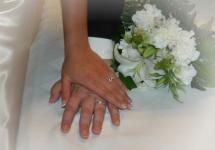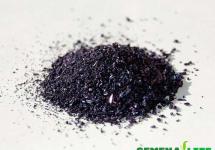Despite the fact that there is such a concept as a factory cement, quite often before the builders of small objects, and simply in everyday life, the question arises of its independent manufacture. Often it is really more convenient and more economical than the purchase of a finished material.

When mixing the solution, it is necessary to strictly observe the proportions of the components and take care of their quality.
There are various techniques how to make cement, allowing you to make it with your own hands.
Properties and composition of cement

The ratio of cement and sand in a solution for masonry should be 1: 3.
In the construction of housing, materials such as brick, block, wall panel are needed. And sometimes in order to make the erected structure of durable, these materials need to tie so that the monolithic system is. Portland cement is used for such purposes. Its strength characteristics are calculated by the coefficient of strength during bending or compressing the composition, the basis of which is sand and cement, correlated in parts 3: 1. For almost a month, this solution is contained when complying with a special temperature mode and moisture mode. There are various options for this type of cement that meet different operational requirements. For example, special resistance to moisture.
In general, in any composition used for construction, water, sand, which is aggregate, binders: cement, lime, gypsum powder. Make an independently such a solution is extremely simple: mix dry cement with dry sand (lime), and the sand must be 2-5 parts. Or knead 1 cement share with 2 limestones, adding up to 9 stakes of sand. The resulting mixture is used to build foundations and walls, with a device of a screed on the floor, plastering (external and internal), as well as where high humidity is possible.

Sand used to prepare a solution must be clean and sifted through a special sieve.
It is worthwing to know that when mixing the solution, it is necessary to correctly comply with the proportions of the components depending on which the mixture is used. So, for foundations, we make the cement and sand in the ratio of 1: 1 or 1: 2, when performing masonry work - 1: 3, plastering - 1: 6. The quality of the mixtures made will affect the amount of liquid in their composition, which should not be less than 65%. This gives a solution to flexibility and plasticity, not only facilitates construction work, but also affects the durability of the construction erected.
So, to comply with these norms in the manufacture of the solution, only warm water is taken, poured it into the pre-mixed components carefully, then the resulting stirred is thoroughly. Minds the homogeneity of the resulting mixture, and for this particular attention should be paid to the quality of the sand used, it should be clean and sifted through a special sieve. You can not take a river or mounted sand. If gravel is added, it should also be penetrating and dried.
When mixing, regardless of how much you want to get, all components are gradually embanked. An ordinary drill with a screw-like nozzle can be used as utility facilities. Make the solution will be convenient, using a large trough or an old bath. The resulting mixture should be used quickly - no later than half an hour later, then it loses flexibility, starts to be covered with crust and hardens.
In the process of acquiring materials for the building mortar, pay attention to the conditions for storage. Dry cement should be dry, and not swelling from excessive humidity. Ideally, he must be stored in a warm and dry place.
Thus, on the quality of cement made by its own hands, invariably affect the properties of the source components, the conditions for their storage and use, the correct and thorough kneading solution.
Cement protection from frost

To prevent cement cracking under the influence of minus temperatures, a conventional solution of soda should be used.
A serious problem in conducting external construction works is the problem of cracking cement. The main enemy is cold. Curiously, but a fact: to prevent this, an ordinary solution of soda should be used. The Austrian engineer proved that such a solution protects Portland cement from the effects of minus temperatures. For the purpose of experiment, the lime was taken - 1 portion in relation to cement, 1 portion of lime and 3 sand, soda solution was added to the finished cement so that 1 l cement accounted for 1 kg of soda diluted in 3 liters of water. Next, the mixture was kept about 15 hours at a temperature of -32 °, then dried 3 hours. As a result, cement absolutely did not change its properties. Conclusion: adding soda dissolved in the portland cement dissolved in water, you can guarantee high frost resistance to the cement used.
Cement for different needs
It is most difficult to make cement for laying stone and plastering. The process will require special knowledge, strict follow-up proportions and consumption of only quality components. There are technologies for the manufacture of solutions with special properties. For example, cement based on the caustic of lime is used for sealing ground flooring (water-based lime is mixed with ash and water until the viscous cashem opens); Repair of iron products (30 portions of pushed graphite, 15 - lime, 40 - blankets are mixed, linseed-based lacquer is added). For lull diamonds, 30 servings of lead Gletta are taken, 10 - lime, 20 - soaps, 50 - graphite, all this is mixed with flax oil. The zinc mask is made of 20 portions of lime, 4 sulfur, which are mixed with 10 portions of hot glue, as part of which 7 portions is water. The smelting for furnaces is prepared on the basis of equal parts of graphite, bone coal, sand, lime mixed with bull blood or wet curd.

The cooked cement quickly loses flexibility, begins to be covered with crust and hardens, so it should be used it no later than half an hour.
The "ideal cement" is called cement made from a lead gurten powder dried in the furnace and mixed with glycerin. The solution is superior to its strength qualities of Portland variety. In addition, it is completely not afraid of moisture, high temperatures, does not form cracks (does not change the volume during solidification), has a unique property to glue any materials.
There is still a Chinese cement preparation recipe, which perfectly glues the skin, marble, plaster, faience, china and much more. Its viscous composition includes 54 portions of lime mixed with 6 portions of powdered quadses, 40 servings of fresh whipped animal blood are added, all stirring well. Such cement in liquid form becomes excellent waterproof paint.
Optimal recipes
Make a cement for gluing minerals, mixing 6 portions of mastic with a part Belil based on lead, trusheys The resulting composition in fine powder, which is further added, stirring, in a white wax melted on fire. Ready mass very firmly connects even stones, not to mention other subjects. The desired color can be obtained by adding a little paint during the preparation.

The enemies of cement are: humidity and carbon dioxide. The loss of cement activity can be up to 15% each month.
In order to cement the plates or stones, use the following composition. One portion of sulfur and resin dissolved in different tanks is connected, then put, stirring, 3 portions of powder powder of lead, 2 portions of grinding sand. Dry slabs or stones are lubricated with oil, after which the cracks and gaps are poured with a finished mixture. Such a coating well protects a stone from precipitation and temperature drops.
Cement gluing glass can also be prepared with their own hands, and in different ways. One portion of powdered lime is triturated with 2.5 portions of egg protein, 1 portion of water and 5.5 - gypsum are added, immediately applied to the gluing surface. Or: 10 portions of gelatin are dissolved on a small fire, connecting with 15 portions of acetic essence, then 5 ammonium portions of a two-axis are added. This composition can be stored in a dark bottle and dark room.
It is quite difficult to stick glass on a metal surface. Such cement is suitable for these purposes. We take 125 g of powdered rosin, 36 grams of white wax, 75 grams of iron, heating them on a small fire, when the liquid is formed, removed from the fire, it is extremely gently adding 18 grams of high-quality turpidar, mixed with a wooden spoon and cool. Either: 10 portions of resin and a portion of wax (yellow) melting on fire, such a mixture is well glued glass on metal.
How to make cement? The question is, at first glance, complex. But, following these recommendations, it is possible to make cement not only for construction, but also to solve many other frequently emerging household problems.


